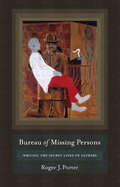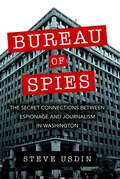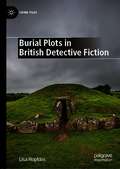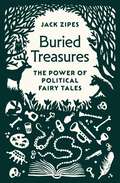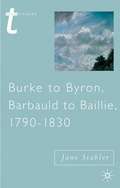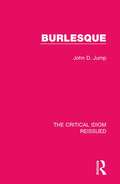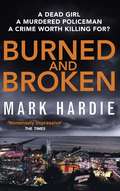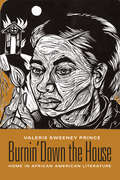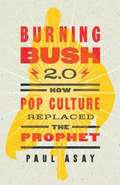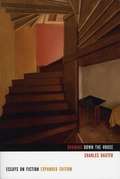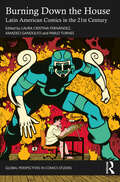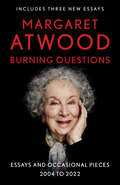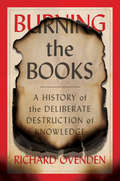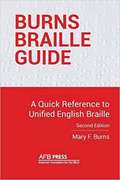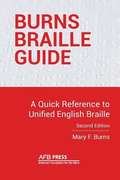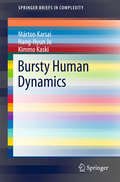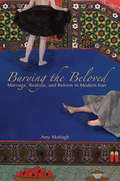- Table View
- List View
Bureau of Missing Persons: Writing the Secret Lives of Fathers
by Roger J. PorterA devoted reader of autobiographies and memoirs, Roger J. Porter has observed in recent years a surprising number of memoirs by adult children whose fathers have led secret lives. Some of the fathers had second families; some had secret religious lives; others have been criminals, liars, or con men. Struck by the intensely human drama of secrecy and deception played out for all to see, Porter explores the phenomenon in great depth. In Bureau of Missing Persons he examines a large number of these works—eighteen in all—placing them in a wide literary and cultural context and considering the ethical quandaries writers face when they reveal secrets so long and closely held. Among the books Porter treats are Paul Auster’s The Invention of Solitude, Alison Bechdel’s graphic memoir Fun Home, Essie Mae Washington-Williams’s Dear Senator (on her father, Strom Thurmond), Bliss Broyard’s One Drop, Mary Gordon’s The Shadow Man, and Geoffrey Wolff’s The Duke of Deception. He also discusses Nathaniel Kahn’s documentary film, My Architect. These narratives inevitably look inward to the writer as well as outward to the parent. The autobiographical children are compelled, if not consumed, by a desire to know. They become detectives, piecing together clues to fill memory voids, assembling material and archival evidence, public and private documents, letters, photographs, and iconic physical objects to track down the parent.
Bureau of Spies: The Secret Connections between Espionage and Journalism in Washington
by Steven T. UsdinBrings to light the long history of spies posing as journalists in Washington. Covert intelligence gathering, propaganda, fake news stories, dirty tricks--these tools of spy craft have been used for seven decades by agents hiding in plain sight in Washington's National Press Building. This revealing book tells the story of espionage conducted by both US and foreign intelligence operatives just blocks from the White House. Journalist Steven T. Usdin details how spies for Nazi Germany, imperial Japan, the Soviet Union, and the CIA have operated from the offices, corridors, and bars of this well-known press center to collect military, political, and commercial secrets. As the author's extensive research shows, efforts to influence American elections by foreign governments are nothing new, and WikiLeaks is not the first antisecrecy group to dump huge quantities of classified data into the public domain. Among other cases, the book documents the work of a journalist who created a secret intelligence organization that reported directly to President Franklin Roosevelt and two generations of Soviet spies who operated undercover as TASS reporters and ran circles around the FBI. The author also reveals the important roles played by journalists in the Cuban missile crisis, and presents information about a spy involved in the Watergate break-in who had earlier spied on Republican presidential candidate Barry Goldwater for then-President Lyndon Johnson. Based on interviews with retired CIA, NSA, FBI, and KGB officers, as well as declassified and leaked intelligence documents, this fascinating historical narrative shows how the worlds of journalism and intelligence sometimes overlap and highlights the ethical quandaries that espionage invariably creates.
Burial Plots in British Detective Fiction (Crime Files)
by Lisa HopkinsBurial Plots in British Detective Fiction offers an overview of the ways in which the past is brought back to the surface and influences the present in British detective fiction written between 1920 and 2020. Exploring a range of authors including Agatha Christie, Patricia Wentworth, Val McDermid, Sarah Caudwell, Georgette Heyer, Dorothy Dunnett, Jonathan Stroud and Ben Aaronovitch, Lisa Hopkins argues that both the literal and literary disinterment of the past use elements of the national past to interrogate the present. As such, in the texts discussed, uncovering the truth about an individual crime is also typically an uncovering of a more general connection between the present and the past. Whether detective novels explore murders on archaeological digs, hauntings, cold crimes or killings at Christmas, Hopkins explores the underlying message that you cannot understand the present unless you understand the past.
Buried Treasures of Chinese Turkestan: An Account of the Activities and Adventures of the Second and Third German Turfan Expeditions (Routledge Revivals)
by Albert von Le CoqFirst published in 1928, this volume constituted the results of expeditions by the famous archaeologist and explorer of Central Asia, Albert von Le Coq. Funded by the last German emperor, Wilhelm II, and von Le Coq’s own brewing and winery empire, the second and third German expeditions ventured to Turfan in the Xinjiang region of China. Travelling East expecting to find Greek influences, the expedition in fact uncovered extensive networks of Buddhist and Manichaean cave temples in the Northwest China. This volume includes extensive images in addition to a record of the expedition’s journeys and discoveries.
Buried Treasures: The Power of Political Fairy Tales
by Jack ZipesFascinating profiles of modern writers and artists who tapped the political potential of fairy talesJack Zipes has spent decades as a “scholarly scavenger,” discovering forgotten fairy tales in libraries, flea markets, used bookstores, and internet searches, and he has introduced countless readers to these remarkable works and their authors. In Buried Treasures, Zipes describes his special passion for uncovering political fairy tales of the nineteenth and twentieth centuries, offers fascinating profiles of more than a dozen of their writers and illustrators, and shows why they deserve greater attention and appreciation.These writers and artists used their remarkable talents to confront political oppression and economic exploitation by creating alternative, imaginative worlds that test the ethics and morals of the real world and expose hidden truths. Among the figures we meet here are Édouard Laboulaye, a jurist who wrote acute fairy tales about justice; Charles Godfrey Leland, a folklorist who found other worlds in tales of Native Americans, witches, and Roma; Kurt Schwitters, an artist who wrote satirical, antiauthoritarian stories; Mariette Lydis, a painter who depicted lost-and-found souls; Lisa Tetzner, who dramatized exploitation by elites; Felix Salten, who unveiled the real meaning of Bambi’s dangerous life in the forest; and Gianni Rodari, whose work showed just how political and insightful fantasy stories can be.Demonstrating the uncanny power of political fairy tales, Buried Treasures also shows how their fictional realities not only enrich our understanding of the world but even give us tools to help us survive.
Buried by The Times: The Holocaust and America's Most Important Newspaper
by Laurel LeffAn in-depth look at how The New York Times failed in its coverage of the fate of European Jews from 1939-45. It examines how the decisions that were made at The Times ultimately resulted in the minimizing and misunderstanding of modern history's worst genocide. Laurel Leff, a veteran journalist and professor of journalism, recounts how personal relationships at the newspaper, the assimilationist tendencies of The Times' Jewish owner, and the ethos of mid-century America, all led The Times to consistently downplay news of the Holocaust. It recalls how news of Hitler's 'final solution' was hidden from readers and - because of the newspaper's influence on other media - from America at large. Buried by The Times is required reading for anyone interested in America's response to the Holocaust and for anyone curious about how journalists determine what is newsworthy.
Burke to Byron, Barbauld to Baillie, 1790–1830
by Jane StablerThis volume provides an introduction to Romantic period texts for students and teachers. Each chapter places key works of drama, poetry and prose in their cultural context and demonstrates how historically-informed close-reading can enrich our view of British literature. Framing chapters on the years 1790 and 1830 explore the transitions that shaped Romantic literature from 18th-century Enlightenment culture to the revolutionary expectations of the nineteenth century and the dawn of the Victorian era. The book examines not only the Big Six (Blake, Wordsworth, Coleridge, Byron, Shelley and Keats), but also a fuller range of writers from the period, including women writers such as Anne Barbauld and Sarah Baillie.
Burlesque (The Critical Idiom Reissued #21)
by John D. JumpFirst published in 1972, this book provides a helpful introduction to burlesque literature, a term used by critics from the seventh-century onwards to describe work in which an incongruity between serious subject-matter and style is used to provoke laughter. It examines the four main types of burlesque writing: Travesty, Hudibrastic, Parody and the Mock-Poem, as well as dramatic burlesques.
Burned and Broken: A gripping detective mystery you won't be able to put down (Pearson and Russell)
by Mark HardieA gripping mystery about a woman trying to find out the truth behind the death of her best friend and introducing a brilliant detective duo - perfect for fans of Peter James, Angela Marsons and James Oswald. A DEAD GIRLA vulnerable young woman, fresh out of the care system, is trying to discover the truth behind the sudden death of her best friend.A MURDERED POLICE OFFICERThe charred body of a policeman - currently the subject of an internal investigation - is found in the burnt-out-shell of his car on the Southend seafront.A CRIME WORTH KILLING FOR?To DS Frank Pearson and DC Catherine Russell of the Essex Police Major Investigation Team, the two events seem unconnected. But as they dig deeper into their colleague's murder, dark secrets begin to emerge.Can Pearson and Russell solve both cases, before more lives are destroyed?A twisty, gripping novel that introduces a brilliant new detective duo. If you like Peter James, Angela Marsons and James Oswald, then you'll love this crime debut. TRULY EVIL, the gripping second book in the series is out now. ****Praise for Burned and Broken:'Immensely impressive' The Times'The investigation into a copper's dramatic death in downbeat Southend scoops a cast of equally downbeat characters into its net, and tensions rise as their stories fold around each other. An accomplished debut' Sunday Times'Emotional, intelligent, sensual and with such a strong voice, Burned and Broken by Mark Hardie is a crime debut that deserves huge success' Harry Illingworth (Goldsboro Books)'I absolutely LOVED, LOVED, LOVED this book and I would recommend it to anybody. I can't wait to read more investigations led by DS Frank Pearson and DC Cat Russell' Amanda Oughton (Ginger Book Geek)'The story is easy to follow without being too simple, and the novel really manages to evoke a sense of atmosphere and reality within its pages. I didn't find myself becoming distracted whilst reading at all, and raced through it in hours. I will certainly be reading any future novels, particularly in this series which I wholeheartedly enjoyed' Laura Naz (Snazzy Books)
Burned and Broken: A gripping detective mystery you won't be able to put down (Pearson and Russell)
by Mark HardieAn enigmatic policeman - currently the subject of an internal investigation - is found burned to death in his car on the Southend sea front. A vulnerable young woman, fresh out of the care system, is trying to discover the truth behind the sudden death of her best friend.As DS Frank Pearson and DC Catherine Russell from the Essex Police Major Investigation Team are brought in to solve the mystery that surrounds their colleague's death, they're under intense pressure to crack the case without damaging the force's reputation. When a dramatic turn of events casts a whole new light on both cases, the way forward is far from clear. Were the victims connected in some way? And just how much should Pearson and Russell reveal to their bosses as they begin to unearth some dark secrets that the force would rather keep buried?Mark Hardie's stylish and gripping debut introduces a brilliant new detective duo to the world of crime fiction, weaving together two suspenseful stories that end in a breath-taking finale.
Burnin' Daylight: Building a Principle-Driven Writing Program
by Ryan J. DippreRooted in contemporary understandings of social action, informed by up-to-date research on writing program administration, and attentive to the needs of value-driven decision-making, Burnin’ Daylight enables writing program administrators (WPAs) to shape writing programs that help people create the lives they envision. This book guides WPAs through the rough terrain of running a writing program during a period of sustained social and economic upheaval—and through the process of making their programs more principle-driven and sustainable along the way. WPAs face a range of challenges on a regular basis: organizing class schedules, leading professional learning events, conducting program assessments, responding to student needs, meeting with deans and provosts, and more. Additionally, WPAs need to learn about and direct their programs strategically when considering the kind of program they currently have, the sort of program they envision, and how they can transition from one to another. Burnin’ Daylight acts as a roadmap for IRB-approved research and provides WPAs—specifically, new and returning WPAs—with a detailed yet flexible plan for understanding the inner workings of a writing program and how to develop a future trajectory for it. Burnin’ Daylight is for writing program administrators of all experience levels and other administrators interested in taking a “principled practices” approach to their work.
Burnin' Down the House: Home in African American Literature
by Valerie Sweeney PrinceHome is a powerful metaphor guiding the literature of African Americans throughout the twentieth century. While scholars have given considerable attention to the Great Migration and the role of the northern city as well as to the place of the South in African American literature, few have given specific notice to the site of "home." And in the twenty years since Houston A. Baker Jr.'s Blues, Ideology, and Afro-American Literature appeared, no one has offered a substantial challenge to his reading of the blues matrix. Burnin' Down the House creates new and sophisticated possibilities for a critical engagement with African American literature by presenting both a meaningful critique of the blues matrix and a careful examination of the place of home in five classic novels: Native Son by Richard Wright, Invisible Man by Ralph Ellison, The Bluest Eye and Song of Solomon by Toni Morrison, and Corregidora by Gayl Jones.
Burning Bush 2.0: How Pop Culture Replaced the Prophet
by Paul AsayMaybe God doesn’t speak through prophets as often these days because he knows people wouldn’t listen. Maybe God speaks to us in different ways—and in the places he knows where we congregate: in our movie theaters, living rooms, iPods, and smartphones. Maybe God still longs to connect with us, and so goes into the places where we’re most likely to listen. Burning Bush 2.0 is a whimsical and sincere examination of the ways God communicates with us—sometimes subtly and secretly—through our media and entertainment streams. Asay examines how faith and God’s fingerprints mark movies and music, television and technology. Through word and picture, God still speaks to us through unsuspecting voices—in ways we’re best able to hear—even if we don’t fully comprehend it completely in the moment. God is everywhere, and doesn’t ask permission to speak, shout out, or whisper his name. Includes study guide for individuals and church groups.
Burning Down The House: Essays On Fiction
by Charles BaxterAs much a rumination on the state of literature as a technical manual for aspiring writers, Burning Down the House has been enjoyed by readers and taught in classrooms for more than a decade. Readers are rewarded with thoughtful analysis, humorous one-liners, and plenty of brushfires that continue burning long after the book is closed.
Burning Down the House: Essays on Fiction
by Charles BaxterGraywolf reissues one of its most successful essay collections with two new essays and a new foreword by Charles BaxterAs much a rumination on the state of literature as a technical manual for aspiring writers, Burning Down the House has been enjoyed by readers and taught in classrooms for more than a decade. Readers are rewarded with thoughtful analysis, humorous one-liners, and plenty of brushfires that continue burning long after the book is closed.
Burning Down the House: Latin American Comics in the 21st Century. (Global Perspectives in Comics Studies)
by Laura Cristina Fernández Amadeo Gandolfo Pablo TurnesBurning Down the House explores the political, economic and cultural landscape of 21st-century Latin America through comics. It examines works from Argentina, Brazil, Bolivia, Chile, Uruguay, Perú, Colombia, México and Spain, and the resurgence of comics in recent decades spurred by the ubiquity of the Internet and reminiscent of the complex political experiences and realities of the region. The volume analyses experimentations in themes and formats and how Latin American comics have become deeply plural in its inspirations, subjects, drawing styles and political concerns while also underlining the hybrid and diverse cultures they represent. It examines the representative and historical images in a state of emergency and political upheaval; decolonial perspectives and social struggles linked to ethnic and sexual minorities. It looks at how Latin American comics are made right now – from a diverse and autochthonous Latin American perspective. With a wide array of illustrations, this book in the Global Perspectives in Comics Studies series will be an important resource for scholars and researchers of comic studies, Latin American studies, cultural studies, English literature, political history and post-colonial studies.
Burning Man: The Trials of D. H. Lawrence
by Frances WilsonShortlisted for the James Tait Black PrizeAn electrifying, revelatory new biography of D. H. Lawrence, with a focus on his difficult middle years“Never trust the teller,” wrote D. H. Lawrence, “trust the tale.” Everyone who knew him told stories about Lawrence, and Lawrence told stories about everyone he knew. He also told stories about himself, again and again: a pioneer of autofiction, no writer before Lawrence had made so permeable the border between life and literature. In Burning Man: The Trials of D. H. Lawrence, acclaimed biographer Frances Wilson tells a new story about the author, focusing on his decade of superhuman writing and travel between 1915, when The Rainbow was suppressed following an obscenity trial, and 1925, when he was diagnosed with tuberculosis.Taking after Lawrence’s own literary model, Dante, and adopting the structure of TheDivine Comedy, Burning Man is a distinctly Lawrentian book, one that pursues Lawrence around the globe and reflects his life of wild allegory. Eschewing the confines of traditional biography, it offers a triptych of lesser-known episodes drawn from lesser-known sources, including tales of Lawrence as told by his friends in letters, memoirs, and diaries. Focusing on three turning points in Lawrence’s pilgrimage (his crises in Cornwall, Italy, and New Mexico) and three central adversaries—his wife, Frieda; the writer Maurice Magnus; and his patron, Mabel Dodge Luhan—Wilson uncovers a lesser-known Lawrence, both as a writer and as a man.Strikingly original, superbly researched, and always revelatory, Burning Man is a marvel of iconoclastic biography. With flair and focus, Wilson unleashes a distinct perspective on one of history’s most beloved and infamous writers.
Burning Questions: Essays and Occasional Pieces, 2004 to 2021
by Margaret AtwoodIn this brilliant selection of essays, the award-winning, best-selling author of The Handmaid's Tale and The Testaments offers her funny, erudite, endlessly curious, and uncannily prescient take on everything from debt and tech to the climate crisis and freedom and the importance of how to define granola—and seeks answers to Burning Questions such as... <p><p> • Why do people everywhere, in all cultures, tell stories? • How much of yourself can you give away without evaporating ? • How can we live on our planet? • Is it true? And is it fair? • What do zombies have to do with authoritarianism? <p><p> In more than fifty pieces, Atwood aims her prodigious intellect and impish humour at the world, and reports back to us on what she finds. This roller-coaster period brought the end of history, a financial crash, the rise of Trump, and a pandemic. From debt to tech, the climate crisis to freedom; from when to dispense advice to the young (answer: only when asked) to how to define granola, we have no better guide to the many and varied mysteries of our universe.
Burning Questions: Essays and Occasional Pieces, 2004-2022
by Margaret AtwoodFrom cultural icon Margaret Atwood comes a brilliant collection of essays--funny, erudite, endlessly curious, uncannily prescient--which seek answers to Burning Questions such as: Why do people everywhere, in all cultures, tell stories? How much of yourself can you give away without evaporating? How can we live on our planet? Is it true? And is it fair? What do zombies have to do with authoritarianism? In over fifty pieces Atwood aims her prodigious intellect and impish humour at the world, and reports back to us on what she finds. This roller-coaster period brought the end of history, a financial crash, the rise of Trump and a pandemic. From debt to tech, the climate crisis to freedom; from when to dispense advice to the young (answer: only when asked) to how to define granola, we have no better guide to the many and varied mysteries of our universe.
Burning the Books
by Richard OvendenThe director of the famed Bodleian Libraries at Oxford narrates the global history of the willful destruction—and surprising survival—of recorded knowledge over the past three millennia.Libraries and archives have been attacked since ancient times but have been especially threatened in the modern era. Today the knowledge they safeguard faces purposeful destruction and willful neglect; deprived of funding, libraries are fighting for their very existence. Burning the Books recounts the history that brought us to this point.Richard Ovenden describes the deliberate destruction of knowledge held in libraries and archives from ancient Alexandria to contemporary Sarajevo, from smashed Assyrian tablets in Iraq to the destroyed immigration documents of the UK Windrush generation. He examines both the motivations for these acts—political, religious, and cultural—and the broader themes that shape this history. He also looks at attempts to prevent and mitigate attacks on knowledge, exploring the efforts of librarians and archivists to preserve information, often risking their own lives in the process.More than simply repositories for knowledge, libraries and archives inspire and inform citizens. In preserving notions of statehood recorded in such historical documents as the Declaration of Independence, libraries support the state itself. By preserving records of citizenship and records of the rights of citizens as enshrined in legal documents such as the Magna Carta and the decisions of the US Supreme Court, they support the rule of law. In Burning the Books, Ovenden takes a polemical stance on the social and political importance of the conservation and protection of knowledge, challenging governments in particular, but also society as a whole, to improve public policy and funding for these essential institutions.
Burns Braille Guide
by Mary F. BurnsThe perennial favorite resource for teachers and transcribers, The Burns Braille Transcription Dictionary has been revamped as the Burns Braille Guide to usher in the new era of Unified English Braille (UEB). The revised and updated edition reflects the range of changes introduced in the transition from English Braille American Edition (EBAE) to UEB. This easy-to-use reference guide includes common braille to print and print to braille conversions, as well as punctuation, new UEB contractions, and general rules and terminology. <P><P><i>Advisory: This book offers only partial accessibility. We have kept it in the collection because it is useful for some of our members. Benetech is actively working on projects to improve accessibility issues such as these in the future.</i>
Burns Braille Guide: A Quick Reference To Unified English Braille
by Mary F. BurnsThe perennial favorite resource for teachers and transcribers, The Burns Braille Transcription Dictionary has been revamped as the Burns Braille Guide to usher in the new era of Unified English Braille (UEB). The revised and updated edition reflects the range of changes introduced in the transition from English Braille American Edition (EBAE) to UEB. This easy-to-use reference guide includes common braille to print and print to braille conversions, as well as punctuation, new UEB contractions, and general rules and terminology.
Bursty Human Dynamics (SpringerBriefs in Complexity)
by Márton Karsai Hang-Hyun Jo Kimmo KaskiThis book provides a comprehensive overview on emergent bursty patterns in the dynamics of human behaviour. It presents common and alternative understanding of the investigated phenomena, and points out open questions worthy of further investigations. The book is structured as follows. In the introduction the authors discuss the motivation of the field, describe bursty phenomena in case of human behaviour, and relate it to other disciplines. The second chapter addresses the measures commonly used to characterise heterogeneous signals, bursty human dynamics, temporal paths, and correlated behaviour. These definitions are first introduced to set the basis for the discussion of the third chapter about the observations of bursty human patterns in the dynamics of individuals, dyadic interactions, and collective behaviour. The subsequent fourth chapter discusses the models of bursty human dynamics. Various mechanisms have been proposed about the source of the heterogeneities in human dynamics, which leads to the introduction of conceptually different modelling approaches. The authors address all of these perspectives objectively, highlight their strengths and shortcomings, and mention possible extensions to them. The fifth chapter addresses the effect of individual heterogeneous behaviour on collective dynamics. This question in particular has been investigated in various systems including spreading phenomena, random walks, and opinion formation dynamics. Here the main issues are whether burstiness speeds up or slows down the co-evolving processes, and how burstiness modifies time-dependent paths in the system that determine the spreading patterns of any kind of information or influence. Finally in the sixth chapter the authors end the review with a discussion and future perspectives. It is an ideal book for researchers and students who wish to enter the field of bursty human dynamics or want to expand their knowledge on such phenomena.
Burton Malkiel's A Random Walk Down Wall Street (The Macat Library)
by Nicholas BurtonBurton Malkiel’s 1973 A Random Walk Down Wall Street was an explosive contribution to debates about how to reap a good return on investing in stocks and shares. Reissued and updated many times since, Malkiel’s text remains an indispensable contribution to the world of investment strategy – one that continues to cause controversy among investment professionals today. <P><P>At the book’s heart lies a simple question of evaluation: just how successful are investment experts? The financial world was, and is, full of people who claim to have the knowledge and expertise to outperform the markets, and produce larger gains for investors as a result of their knowledge. But how successful, Malkiel asked, are they really? Via careful evaluations of performance – looking at those who invested via ‘technical analysis’ and ‘fundamental analysis’ – he was able to challenge the adequacy of many of the claims made for analysts’ success. Malkiel found the major active investment strategies to be significantly flawed. Where actively managed funds posted big gains one year, they seemingly inevitably posted below average gains in succeeding years. By evaluating the figures over the medium and long term, indeed, Malkiel discovered that actively-managed funds did far worse on average than those that passively followed the general market index. <P><P>Though many investment professionals still argue against Malkiel’s influential findings, his exploration of the strengths and weaknesses of the argument for believing investors’ claims provides strong evidence that his own passive strategy wins out overall.
Burying the Beloved
by Amy MotlaghBurying the Beloved traces the relationship between the law and literature in Iran to reveal the profound ambiguities at the heart of Iranian ideas of modernity regarding women's rights and social status. The book reveals how novels mediate legal reforms and examines how authors have used realism to challenge and re-imagine notions of "the real." It examines seminal works that foreground acute anxieties about female subjectivity in an Iran negotiating its modernity from the Constitutional Revolution of 1905 up to and beyond the Islamic Revolution of 1979. By focusing on marriage as the central metaphor through which both law and fiction read gender, Motlagh critically engages and highlights the difficulties that arise as gender norms and laws change over time. She examines the recurrent foregrounding of marriage at five critical periods of legal reform, documenting how texts were understood both at first publication and as their importance changed over time.
